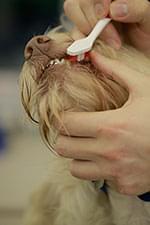Brushing your dog’s teeth regularly will help prevent painful dental problems later on. But it needn’t be a chore and can actually be an enjoyable time for both of you. Vet Brian Faulkner explains how to do it.
It’s important to start good dental habits early to help maintain strong, healthy teeth and to help prevent painful gum inflammation, tooth loss and infections later on. Ideally, you should brush your dog’s teeth every day.
Build positive associations

The first step is getting your dog used to having his or her mouth touched. Start gently by dipping your finger into something like gravy, chicken broth, or another liquid your dog may like.
Call your dog with a voice that means ‘treat’ and let them lick the liquid off your finger. Then touch your soaked finger gently over your dog´s gums and teeth.
After a few sessions, your dog should start looking forward to this.
Introduce texture

Now, place a thin piece of gauze around your finger and dip it in the flavoured liquid. Gently move that finger over your dog’s teeth in a circular motion.
Repeat for a number of sessions until your dog feels comfortable with this procedure. Remember to continue praising your dog and keep an upbeat attitude.
When your pet is used to having the flavoured gauze in his or her mouth, move on to a dog toothbrush, a soft child’s toothbrush, or a thimble brush.
Start by allowing your dog to lick something tasty off the brush or pad to get them used to the consistency – especially the bristles on a brush.
Choose the right toothpaste

Now add a little pet toothpaste. Do not use human toothpaste as the fluoride can irritate your dog’s stomach and the froth often distresses dogs. Pet toothpastes are usually poultry or malt flavours, which most dogs like.
Again, take things slowly to get your dog used to the flavour and consistency of the toothpaste. Let your dog lick some off your finger and then apply some to their gumline with your finger.
Time to brush!

Now you can start the actual brushing. Talk to your dog in a happy voice during the process and praise them at the end.
Start by gently brushing one or both upper canine teeth (the large ones in the front of the mouth). When your dog accepts having several teeth brushed, slowly increase the number you are brushing.
You don’t have to scrub hard, the toothpaste has a chemical action.
Don’t forget the back teeth

The most challenging teeth to reach are the larger molars at the back of the mouth.
To reach these you will need to draw your dog’s lips back. Some dogs don’t like this, but by inserting the brush inside the cheek you may be able to reach these teeth.
Either way, don’t forget about the molars, as they are the most common areas for gum disease secondary to tartar build-up.
And finally, remember to book an annual dental checkup so that your vet can spot any problems as soon as possible. You need to do this for your insurance, too.
